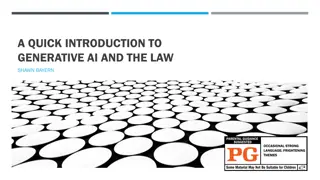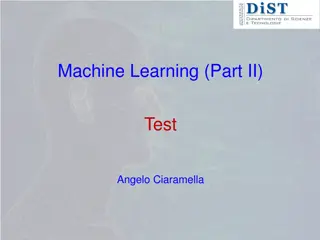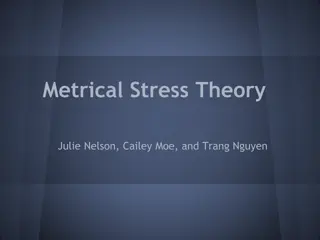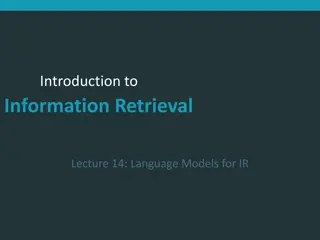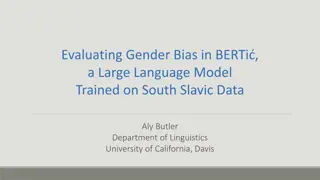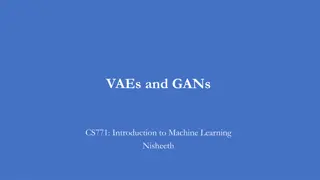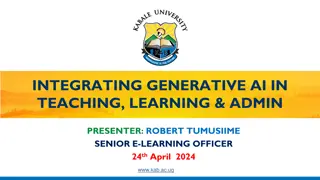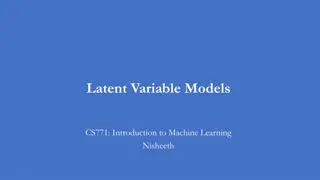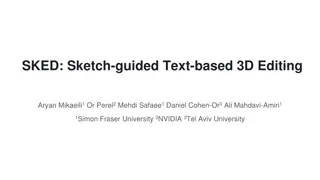Understanding Large Language Models in Generative AI
Large Language Models (LLMs) like chatGPT are statistical pattern-recognition systems that predict the next word in a sequence based on the context. Trained on vast datasets, LLMs cluster words by understanding patterns, not true meaning. They use unsupervised learning and reinforcement to improve responses, aiming for accurate predictions despite some randomness.
Download Presentation

Please find below an Image/Link to download the presentation.
The content on the website is provided AS IS for your information and personal use only. It may not be sold, licensed, or shared on other websites without obtaining consent from the author. Download presentation by click this link. If you encounter any issues during the download, it is possible that the publisher has removed the file from their server.
E N D
Presentation Transcript
Large Language Models Mike Tennant, 5thOctober 2023
Agenda Introduction to generative AI ( genAI ) Key Features Exercises Discussion note: all examples have been developed using chatGPT (3.5 and 4). Other systems (e.g. Bard, Bing, Claude, Ernie Bot) should give similar, but not identical, results.
TLDR; We assume that you re going to use generative AI We encourage you to use it as a tool to help you learn effectively
How Do Large Language Models (LLMs) Work? At their most basic LLMs are statistical pattern-recognition and prediction systems LLMs output the next likely word ( token ) in a sentence ( sequence ) token: unit of text e.g. word, character. 1 word ~ 0.75 token sequence: context - section ( window ) of text e.g. sentence, paragraph, book input into chatGPT is 4096 tokens; Claude 2 is 100K tokens The likelihood of the next work appearing is determined by the context in which the words are seen in a larger body of text ( corpus ) and the input to the chat
LLMs Understand Meaning Learning from a large corpus allows LLMs to understand the meaning of words. For example the training data may consist of many sentences beginning with my favourite colour is the next word will be a colour, allowing LLMs to cluster the words red, blue, green into a set that represents the concept of colour It s important to note that LLMs don t really understand anything. They create statistical patterns that groups similar tokens based on a complex measure of how similar or dissimilar they are.
Data used to Train LLMs LLMs are trained in an unsupervised manner on vast quantities of open source and licensed data e.g. The Pile (825GB, incl. web, papers, patents, books, ArXiv, Stack Exchange, maths problems, computer code) Common Crawl (~20B URLs) GPT3: 175B parameters; GPT4: undisclosed: est. 500B 1000B - bigger is better (for now, at least) Responses are refined using question-response pairs ( InstructGPT ) from the web, humans or bootstrapped (i.e. the LLM outputs its own pairs) reinforcement learning with human feedback (RLHF) is used to reward LLMs to give appropriate responses ( guardrails ) Constitutional AI trained to filter responses based on e.g. Universal Declaration of Human Rights (Claude 2)
Next Word Prediction is influenced by the frequency the word is seen in various contexts but there is a degree of randomness so that the word with the highest probability isn t always seen green red pink puce 9.7% 15% 11.6% 2.3% My favourite colour is
Meanings can change based on context In each these examples the meaning of the same word changes over time
LLMs can (seem to) be creative A consequence of context-based learning and randomness allows the LLMs to generate surprising outputs. Note though that they re not creative in a human sense, but driven by pattern recognition and prediction algorithms We can use LLMs to: identify weakly similar concepts from different disciplines and help understand different disciplines generate diverse narratives help with ambiguity role playing
Beware! LLMs may seem to lie and hallucinate i.e. give what are factually- incorrect responses to questions* as you now know, they re not trained to do give you an objectively correct answer! this is some function of training data (e.g. bias), learning, search and probability don t believe the outputs they always need checking, at least for now * LLMs aren t people. They have no intentionality. Don t anthropomorphise them
Interacting with LLMs using Prompt Engineering Remember that the output of a LLM is determined by both what the system has been trained on and what information you give it Prompt engineering means tailoring your questions and input so you can get the most out of an LLM Prompts can take many forms, from instructing the LLM to take on a role (e.g. a helpful teacher, a pirate) or guiding the way it should process its output (e.g. chain of thought or a particular method).
LLMs can help you engineer prompts prompts shouldn t be too precise ( What s the capital of England? ), or too vague ( Tell me about sustainability ) sometimes you may not know how to ask an LLM to do a task ask it what it needs and collaborate with it E.g. What could I ask you to help me refine my aims for an essay? Do you need any more information?
Exercise: Understanding Complex Concepts I m going to ask you to simplify a piece of text using your LLM of choice. Choose either of the examples in the notes box Firstly, I d like you to think through the process how would you do it manually? what strategies would you use? what would you focus on? In pairs, spend 5 minutes detailing the steps you would take to manually simplify a text so you can understand it. You should then work with the LLM to help you understand your text Further application: working with an LLM to help you with your aim and objectives for your SGS essay. Note: the rubrics are online.
Exercise: Role Play We re all prone to group-think. bias and defensive thinking or aggressive actions. This ideology isn t good for progress! LLMs can help us understand other s points of view by playing the role of people who may think differently from us. Think of them as providing a safe space for ideological debate! In pairs, think of a group of people who differ ideologically from you e.g. right wing left wing; capitalist socialist; nationalism globalism feminism traditionalism authoritarianism libertarianism instruct your LLM to adopt these two roles and debate net zero. Tell it to strictly keep to these roles. ask the LLM to analyse the conversation and recommend some further reading
Exercise: Socratic Conversations (to do later) The Socratic method in teaching is where the teacher ask you open-ended questions to help explore a topic Helps critical thinking, wider and deeper understanding Easy to set up in an LLM Ask your LLM to take the role of a helpful teacher to explain the steps involved in Socratic conversations this acts as a guide to prompt you for a topic and then use those steps as part of Socratic conversation you may have to intervene until you get correct behaviour. Remember that this acts to guide the LLM!
Exercise: Testing your understanding (to do later) You can instruct an LLM to text your understanding of a topic using multiple choice questions and free-form answers Try to set this up, noting: it will very likely default to a standard one correct/three incorrect MCQ model ask it what other formats it knows about make sure to instruct it to stop after each question and explain the answer once you ve entered your response. see if you can get it behave like a computer-aided testing ( CAT ) system
Using LLMs on the MSc You could get chatGPT to do all your assignments, and possibly pass or you could be smart and use it to help you get a better understanding of the material for example, you could use it to help you develop your aim and objectives for your SGS essay, or, use it to help you structure text or refine your writing style can be helpful if you haven t written essays for a while, or if English isn t your first language
Conversational AI: Imperial Policy Conversational AI (cAI) includes chatGPT, Bard, Bing and all similar tools There can be an educational benefit to using cAI appropriately Submitting work and assessments created by someone or something else, as if it was your own, is plagiarism and is a form of cheating and this includes AI- generated content. using chatGPT etc. would likely constitute intentional cheating and could result you failing an assessment and thus the MSc. https://www.imperial.ac.uk/about/leadership-and-strategy/provost/vice-provost-education/generative-ai- tools-guidance/
What you cant do, some things you could do, and why you should do Can t cAI cannot be an author or co-author; you can t get it to write for you in whole or in part cAI cannot be cited or referenced cAI cannot think for you! Could proof-reading, but why not use Grammarly? identify publications, but why not use Scopus/Scholar/Elicit/ScholarAI summarising ideas, but why not use Wikipedia? it can suggest ways to restructure, but why not speak to your supervisor?
TLDR; We assume that you re going to use generative AI. We ve redesigned parts of our marking schemes to take that into account. We encourage you to use it to help you learn effectively and not do your work for you. This may be treated as plagiarism! Similarly, we recommend that you use other tools to help you do more formulaic work (e.g. reference manager software) and allow you to concentrate on your ideas. Your ingenuity is the thing that s going to save the world!
Examples Mike s chatGPT archive. Note that these are all done using chatGPT-4
Exercise: Simplification GenAI can be used to simplify text This simplification can be done at various levels of complexity This is an iterative process In chatGPT type in the following, using your text read in and acknowledge the following text. Wait for further instructions: YOUR TEXT HERE please simplify the text does anything need further simplification, or expanding/illustrating? Has it been summarised at a reasonable level (e.g. child, educated reader)? https://chat.openai.com/share/fe8c982e-cda5-465c-ab44-eb996840d8fc # Kraken example
Ask it what it needs to process your request if you re not sure how to develop a reasonable prompt you can prompt the system to ask you for information it needs https://chat.openai.com/share/14790e46-a3f0-4df9-a682-789a994bd157 # Sci-Fi example from Vector magazine Or, you can get it to describe what it considers the intermediate steps I'd like you to make some academic text accessible for me. What information do you need from me to do this successfully? https://chat.openai.com/share/eaf2a21c-3eb0-4a1f-a00c-85cb5e79df79 # Sci-Fi example from Vector magazine you will likely have to steer further
Steerability chatGPT sbehaviour can be steered to take on specific roles e.g. tutor, critic, Socratic partner, pirate (!). Often referred to as taking on a role Output without a steer: https://chat.openai.com/share/2adbdcef-2a27-45cc-af57-1977b2ea6ab5 Same input with steer: You are a pedagogical expert in higher education. You should respond to user input by giving advice on how to best develop and deploy the user s input to students. https://chat.openai.com/share/492ea8bf-1a00-47a2-bd56-5f5ecd075ecf
Exercise: Restructuring text genAI can be used to read unstructured notes, identify themes and restructure https://chat.openai.com/share/f8c6d841-3de2-47b4-a71f-9ecdc3258479 # norm competences Exercise. In chatGPT type in the following, using your text read in and acknowledge the following text. Wait for further instructions: YOUR TEXT HERE please identify the main themes in the text please restructure the text based on those themes play around with restructuring does it need expanding? themes and subthemes can be identified and turned into codes for qualitative analysis
Testing Comprehension Socratic questioning https://chat.openai.com/share/89dd6a17-f6e0-4c50-afdf-b1efd6eb361b # Star Trek: TNG assessing knowledge comprehension # see correct prompt in the notes https://chat.openai.com/share/84ccdd27-5f96-43e3-a596-7989f27487d7 or dialogue: https://chat.openai.com/share/b231b3e0-fd8e-4aa3-ac84-a5d427deffaf
ChatGPT and Essays chatGPT has been used to write code to process data and then write a paper: https://www.nature.com/articles/d41586-023-02218-z so, it can write an SGS essay (of variable quality) https://chat.openai.com/share/334d7da4-bf35-468b-8066-7ef60889e794 # writing an essay based on a suggested title it s not great at referencing, but there s a ScholarAI plug-in for that and https://blog.core.ac.uk/2023/03/17/core-gpt-combining-open-access- research-and-ai-for-credible-trustworthy-question-answering/
Writing A Research Proposal pi ce de r sistance: https://chat.openai.com/share/cb2e9d26-0a1d-4a21-81a9- 9a4d493c2d42





